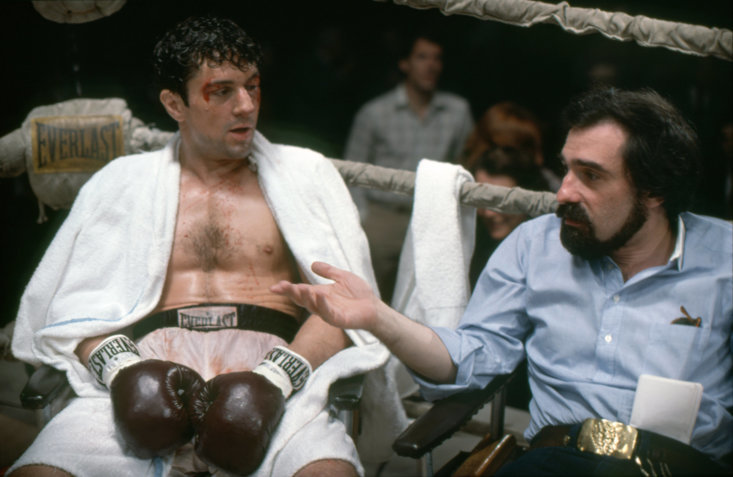“And though I'm no Olivier, if he fought Sugar Ray he would say that the thing ain't the ring, it's the play. So give me a stage where this bull here can rage. And though I could fight, I'd much rather recite. That's entertainment.”
The stilted delivery of a shockingly overweight Robert De Niro, in character as former world middleweight champion Jake LaMotta, introduces the audience to Raging Bull. Martin Scorsese’s bracing boxing opus still packs the same punch today that it did upon its release, 42 years ago. As its director turns 80, The Sportsman celebrates arguably the greatest sports film ever made.
READ MORE:
In 1980, boxing films were all the rage. Rocky had invited a glut of copycats upon its 1976 release. Sylvester Stallone’s beleaguered but beloved pugilist had demonstrated the strength of the formula again in 1979 with the well-received Rocky II. Then as now, ‘The Italian Stallion’ was the measuring stick for every cinematic foray into the squared circle.
But De Niro did not have a plucky underdog tale in mind after reading LaMotta’s autobiography, gifted and personalised to him by the boxer himself . What the Godfather II star took away from the visceral, harsh read was that LaMotta’s story needed to be told warts and all. No amount of Hollywood edge-smoothing would do. ‘The Bronx Bull’ was one of the most complex, aggressive and at times odious men to have ever laced up the gloves. In the book, LaMotta confesses to committing rape, beating his wife and a number of other frankly disgusting indiscretions. The protagonist was about as far from the loveable lug portrayed by Stallone. Rocky Balboa, he wasn’t.
Seeking out frequent collaborator Scorsese, De Niro pleaded his case to make LaMotta’s brutal book into a film. But the iconic director was at his lowest ebb. De Niro visited his friend in hospital after an overdose and found Scorsese reeling from both health concerns and blown confidence. Their last film, New York, New York, had flopped critically and commercially. When Scorsese finally conceded to De Niro’s demands, he did so fully believing Raging Bull would be his last film.
Like their subject, Scorsese and De Niro had to fight to achieve their destiny. Choosing black and white rather than colour to combat the Rocky comparisons, the studio initially rejected their decision. The bigwigs already didn’t like the idea of LaMotta as a protagonist, with one producer terming him “a cockroach”. This disconnect was eventually ironed out, as Scorsese and De Niro fought to make the anti-Rocky.

Less a boxing film than an exploration of rage itself, the scarce fight scenes in the film were meticulously constructed. Raging Bull’s boxing depictions were more horror film grit than action movie glitz. Hershey’s chocolate was used to depict the copious amounts of blood spilled in LaMotta’s fights, as traditional stage blood lacked the visceral, matted gloop Scorsese wanted.
Ingenious details were exploited to tell an emotional tale with the in-ring action. The boxing ring itself steadily increases in size throughout the film until, during the iconic climactic fight with Sugar Ray Robinson, it positively dwarfs De Niro’s LaMotta. This was done to show a man being swallowed whole by his demons, lost in the tides of a world moving on without him.
The ring was not the only thing to expand in size during production. To play the older, post-retirement LaMotta, De Niro packed on 60 pounds. At the time it broke the record for biggest cinematic weight gain. Scorsese was so concerned for his friend’s health that he halted production temporarily.
Despite only ten minutes of boxing being shown in the film, care was taken to make sure every second of it looked legitimate. De Niro trained extensively with the real LaMotta, to the point where the original ‘Raging Bull’ was willing to train and promote him in the professional ranks. De Niro even took part in some amateur fights to prepare for the role, winning two of his three outings.
The gorgeously-realised monochrome, violently realistic fight scenes and unflinching portrayal of LaMotta at both his best and worst made Raging Bull an enduring classic. Forgoing broad-strokes heroism to expose the malice and cruelty that coloured much of LaMotta’s life, the film went where no other boxing movie had gone before. Its reward was a Best Actor Oscar for its star, as well as another for the editing of long-time Scorsese collaborator Thelma Schoonmaker.
While it missed out on the top gong to Robert Redford’s Ordinary People, its legacy in the pantheon of sports films is secure. While Scorsese and De Niro deliberately discarded the well-worn rags-to-riches narrative boxing films favour, the making of the movie was an underdog story of its own. A director at a career and personal low made a beloved film out of a protagonist considered grossly irredeemable even to those financing the film. Raging Bull absolutely should not have worked. But its incongruity and Scorsese’s triumph over adversity are exactly why it does.
*18+ | BeGambleAware | Odds Subject To Change